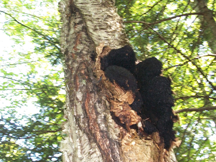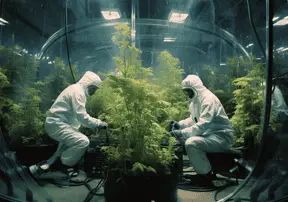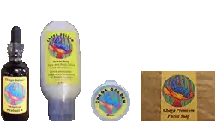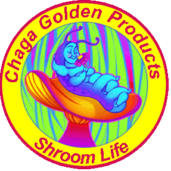Post- Me And My Chaga/Organic Chaga Mushroom/February 12, 2024
Organic Chaga Mushroom?
The terms “Wild” and “Organic” refer to different aspects of how Chaga Mushrooms are sourced and grown:
Wild Chaga
 Wild Chaga refers to mushrooms naturally grown in their native habitat, typically on birch trees in cold climates. Havesting the Chaga mushrooms from their natural environment, and the surrounding ecosystem and environmental conditions allows nature to fluence their growth and development.
Wild Chaga refers to mushrooms naturally grown in their native habitat, typically on birch trees in cold climates. Havesting the Chaga mushrooms from their natural environment, and the surrounding ecosystem and environmental conditions allows nature to fluence their growth and development.
Wild Chaga (Inonotus obliquus) typically grows in cold climates, especially in the northern hemisphere. It most often grows on birch trees, particularly in regions such as Siberia, Russia, Canada, and parts of the United States. Identifying Chaga in the wild requires recognizing its distinctive appearance.
The process of harvesting wild Chaga involves careful extraction to avoid damage to the host tree and preserve the fungus for future growth. Here are the general steps for harvesting:
- Identification: Harvesters need to identify Chaga on birch trees correctly. Chaga has a unique appearance, resembling a dark, irregular mass protruding from the bark.
- Harvesting Tools: Harvesters use tools like a hatchet, chisel, or saw to remove the Chaga from the tree carefully. It’s essential to avoid causing harm to the tree and to take only a portion of the Chaga to allow for its regeneration.
- Ethical Harvesting: Sustainable and ethical harvesting practices involve leaving a portion of the Chaga behind to ensure its continued growth and sustainability. Harvesting too much Chaga from a single tree can harm the host and deplete the local Chaga population.
- Drying: Once harvested, the Chaga is typically dried to reduce moisture content. Drying helps preserve the Chaga and prevents the growth of mold.
 As for determining the health benefits of wild-harvested Chaga, several factors may influence its potency and quality:
As for determining the health benefits of wild-harvested Chaga, several factors may influence its potency and quality:
- Growing Environment: Chaga’s growth environment can impact its chemical composition. Chaga growing in a pristine, unpolluted environment may have a higher concentration of beneficial compounds.
- Host Tree: The specific birch tree species hosting Chaga can influence its chemical profile. Chaga growing on healthy birch trees may contain a broader range of nutrients.
- Age of the Chaga: Older Chaga specimens are often considered more potent. The age of Chaga can be estimated by its size, with larger specimens typically being older.
- Storage Conditions: Proper storage of harvested Chaga, including protection from moisture and contaminants, is crucial to maintaining its quality.
Organic Chaga
 Organic Chaga refers to mushrooms that are grown and harvested following organic farming practices. In the context of mushrooms, organic cultivation involves avoiding synthetic pesticides, herbicides, and fertilizers. Instead, organic growers use natural and sustainable methods to nurture the mushrooms.
Organic Chaga refers to mushrooms that are grown and harvested following organic farming practices. In the context of mushrooms, organic cultivation involves avoiding synthetic pesticides, herbicides, and fertilizers. Instead, organic growers use natural and sustainable methods to nurture the mushrooms.
Some key challenges in cultivating Chaga include:
- Slow Growth: Chaga has a slow growth rate in the wild, and attempts to accelerate its growth in cultivation settings have been challenging.
- Specific Host Trees: Chaga primarily grows on birch trees, and reproducing the symbiotic relationship between Chaga and birch in a controlled environment is not straightforward.
- Nutrient Requirements: Chaga relies on the nutrients and compounds present in the birch tree. Recreating these specific conditions in cultivation poses difficulties.
- Quality and Bioactive Compounds: Wild Chaga is valued for its unique bioactive compounds. Ensuring cultivated Chaga possesses similar medicinal properties and concentrations is a significant challenge.
Currently, Organic Chaga grown under controlled conditions producing the same potential health-enhancing benefits is not in the foreseeable future. So, where does that leave us? Wild Chaga is still the best solution. You can find it in various forms, such as Chaga Tea, Chaga Tincture/Extract, Lotions, Balms, and Soaps, all of which come from Wild-Harvested Chaga.
How do you know you’re getting the best Chaga? Only buy from proven performers with reputation, trustworthiness, meaningful mission statements, and good word of mouth.

Chaga Golden Products constantly strives to offer products of the highest quality, derived from well-matured Chaga, harvested from the most pristine high northern latitudes in a sustainable and caring way. We then correctly dry, store, and extract all the potentially health-enhancing benefits possible in a very thorough way. You can be confident of the quality in every product we offer.
Return to: Chaga Golden Blog
